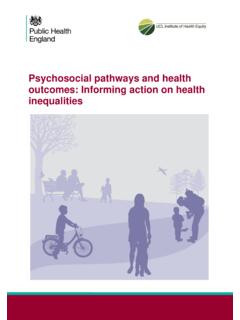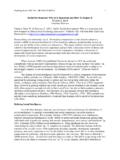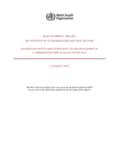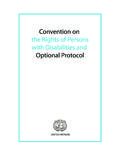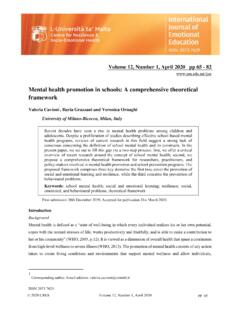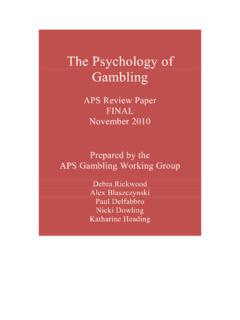Transcription of Students’ Sense of Belonging: The Development of a ...
1 Journal of the Scholarship of Teaching and Learning, Vol. 19, No. 1, February 2019, pp. 117-127. doi: Students Sense of Belonging: The Development of a Predictive Retention Model Glenn M. Davis St. Cloud State University Melissa B. Hanzsek-Brill St. Cloud State University Mark Carl Petzold St. Cloud State University David H. Robinson St. Cloud State University Abstract: Educational institutions increasingly recognize the role that student belonging plays in retention. Many studies in this area focus on helping students improve a Sense of belonging before they matriculate or identifying belonging as a reason for their departure.
2 This study measures students Sense of belonging at key transition points during the first year and finds that social belonging and academic performance are both strong predictors of retention that are not necessarily correlated. These results suggest that a comprehensive, focused outreach protocol that encompasses both social and academic factors could have a positive impact on student persistence. Keywords: social belonging, retention, predictive measures, higher education Soon after St. Cloud State University joined AASCU s Reimagining the First Year initiative, which encourages institutions to think and act boldly when promoting the success of new incoming students, we turned our focus to belonging, which we recognized as the foundation for other strategies we planned to implement to improve students experience.
3 For more than forty years, researchers have recognized the critical role that social and academic integration play in students decisions to remain in college and persist through to graduation (Tinto, 1975; Tinto, 1993; Tinto, 1997; Berger & Braxton, 1998). Hurtado and Carter s (1997) Sense of belonging measure focused on students attachment to the campus community as a whole while other researchers focused on attachment to various external communities or other university contexts (Hoffman, Richmond, Morrow, & Salomone, 2002; Kember & Leung, 2004; Lee & Davis, 2000).
4 Zea, Reisen, Beil and Kaplan (1997) showed that both academic and social integration experiences impacted student persistence in college. In a study of 512 first-year students, Beil et al. (1999) found that academic and social integration predicted students institutional commitments, which in turn influenced their persistence in college after three years. Researchers also have identified distinctions in the way that a Sense of belonging to a campus community can be promoted for members of different student populations, including first-generation students (Woosley & Shepler, 2011; Stephens, Hamedani, & Destin, 2014) and students of color ( Hurtado & Carter, 1997; Steele 1997; Lee & Davis 2000; Lane 2016).
5 More recently, Jorgenson, Farrell, Fudge, and Pritchard (2018) have shown the importance of engaging students in defining what holistic social connectedness looks like on campus. Interventions such as orientation experiences, first-year seminar courses, mentoring, and promoting more intentional engagement with campus activities have all been shown to improve students Sense of belonging, and also their persistence. The work of Walton and Cohen (2007, 2011), Walton and Yeager (2011), and Yeager et al.
6 (2016) demonstrates that it is possible to improve students Sense of belonging before they matriculate, Journal of the Scholarship of Teaching and Learning, Vol. 19, No. 1, February 2019. Davis, Hanzsek-Brill, Petzold, and Robinson and that a short, online activity designed to normalize students concerns about making the transiti on to university had a long-lasting, measurable impact on a variety of success measures, including retention. This impact was especially noticeable among students of color and first-generation college students, who represent a key focus of the Reimagining the First Year project.
7 These and other studies clearly demonstrate the association between belonging and student persistence and that intervention can have a positive impact . What we still hoped to find, however, was a reliable way to measure students Sense of belonging so that we could identify at-risk students and engage them in more focused, individualized outreach designed to improve their chances of persisting to Terms Two and Three. This measurement would need to begin early in students first term, when they are in the process of deciding whether to stay or leave (Levitz & Noel, 1989; Woosley, 2003; Woosley & Miller, 2009).
8 By providing this information to faculty and staff members, we would be able to conduct timely, focused, and meaningful outreach that could have an impact on a student s decision to remain enrolled. Fortunately, our campus community was already comfortable using predictive measures to guide interventions. We currently equip advisors of first-year students with information derived from two predictive tools the Quality Points Predicted (QPP) score, which forecasts students GPA at the end of the first term, and a retention index to guide and inform their outreach.
9 Each of these measures, however, is based primarily on pre-matriculation academic factors , such as ACT score and high-school GPA, along with various demographic factors . While these metrics serve as useful tools for identifying at-risk students, we knew that they did not reveal the whole story. We would consistently lose significant numbers of students whose academic indicators suggested a high probability of retention at the same time we were retaining students whom our existing models suggested would be likely to leave.
10 Since we know that belonging plays a critical role in student persistence, we set out to establish a new predictive index to supplement our existing ones, a model that would allow us to measure first-year students Sense of belonging early in their first term and therefore help us make struggling students more visible to people who could help (Berger & Braxton, 1998). We were encouraged by a study conducted by Woosley and Miller (2009) that demonstrated early assessment was indeed predictive of real challenges to persistence and not merely temporary struggles during a normal college transition.












